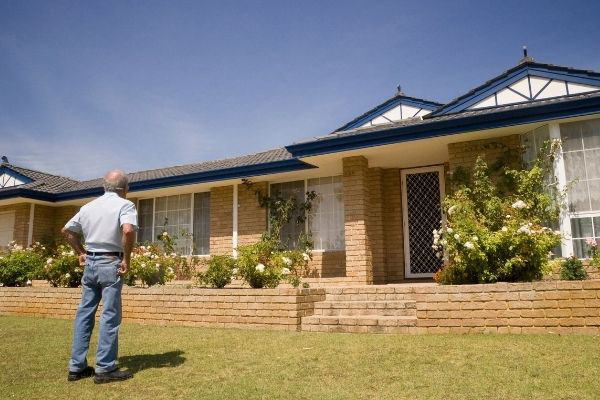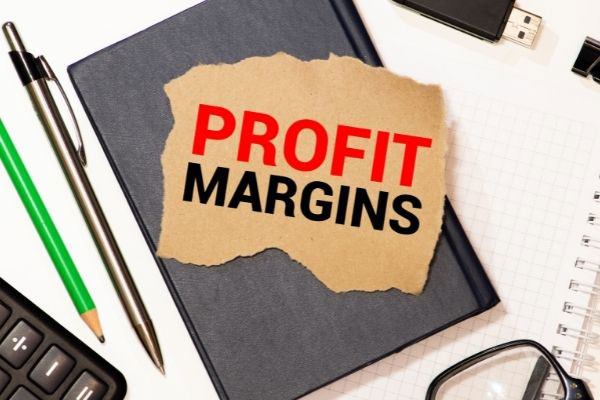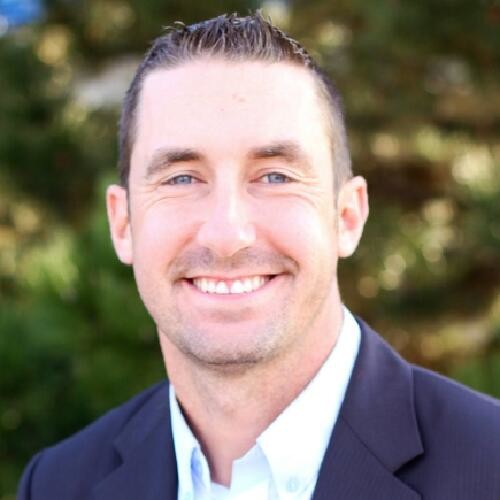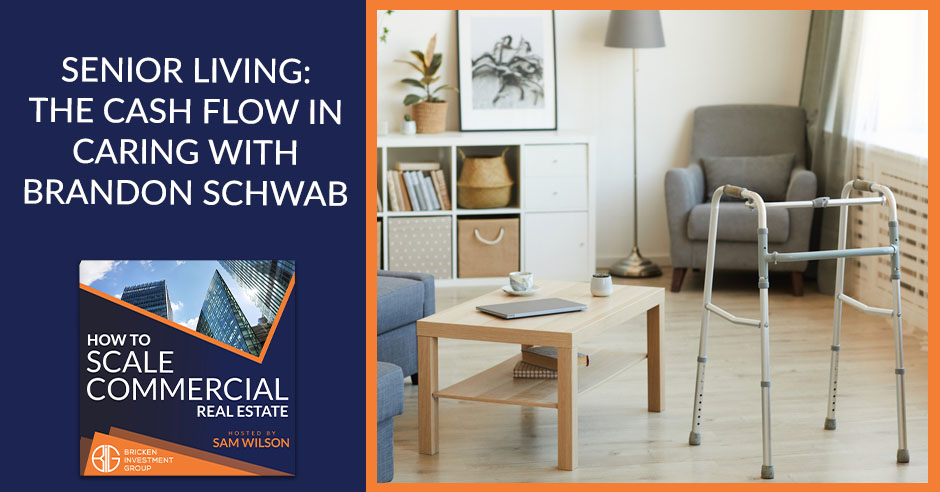Brandon Schwab, founder and CEO of Shepherd Premier Senior Living, takes time to sit with our host, Sam Wilson, to talk about his mission to change the senior living industry from big box to boutique cozy homes. Brandon revisits his past as he talks about his first business and how yearning for passive income introduced him to the art of the Senior Living Business. Brandon takes us on a step-by-step journey of how he bought his first property, his renovation struggles, and how today’s present situation challenged his outlook on the business. Listen in as Brandon shares the secrets to keeping a caregiving business thriving.
—
Watch the episode here:
Listen to the podcast here:
Senior Living: The Cash Flow In Caring With Brandon Schwab
Brandon Schwab has been 100% vertically integrated into the senior housing industry since 2014, with seven locations and $20 million of real estate developed and operated. His mission is to change the senior living industry from big box to boutique cozy homes. Brandon, welcome to the show.
How are you?
I’m great. The pleasure is mine. There are three questions I ask every guest who comes on the show. Can you quickly tell us, where did you start, where you are now, and how did you get there?
I began a detail company when I was fifteen. I opened up my first business detailing cars, boats, and RVs because I thought cars were cool, particularly fancy cars. When I detailed boats, I was exposed to boats, babes, boobs and beer. As soon as I was eighteen, I was heavily interested in all of those Bs. I figured out quickly that RVs help grows our business. I did that company for fourteen years. I’m very dedicated to getting things done. As I’m on something, I do it until it’s done. That’s the place I began.
I was born on an Army base in Kentucky, near Tennessee. I was born on Fort Campbell. My dad passed when I was two and a half. He was an Army OH-58 Chopper Pilot. We came back to Illinois when I was five. My brother is sixteen months younger than me. He’s the company President. The two of us do things together, which is great. It’s a family-operated business.
Fast forward, back to the company, I did the boat detail business all the way through the 2008 crash pretty much full-time. We’ve got our butt-kicked during the 2008 crash because they quit selling RVs. I was the first one to go because they paid me too much, and I was in five states for Camping World, so I was an easy person to cut.
I began learning how to purchase properties and wholesaling properties back in 2010. I did 20 to 30 homes per year for two years. I earned a bunch of active income but I found that after you’ve got a deal done, I didn’t change any place that I was at because I had active income but I didn’t have time. Time was one of the biggest things that I was after. After two years of doing that, I figured out I didn’t get any further down the field because I didn’t go anywhere. I was earning active income but it didn’t have passive income.
In 2012, I started buying and holding properties because I was after passive income. Fortune Builders tells you to go buy 10, 20, 30 homes, hold them for 30 years, and everything is good. That’s pretty much how they pitched it. I had some tenants, kids, clocks, and toilets, all three of them, a finished basement backed up with poop. It was pretty much the thing that broke the camel’s back. I said, “I need to get something else. I’m sick at tenants.” I found that I’m a terrible property to collect payments. I found out when they have kids, I would tend to believe anything they told me. I didn’t always get paid all the time. I was terrible at that.
Our overall purpose is to give the people that are being cared for the best opportunity to get awesome care.
In 2014, I’ve got exposed to a cool business down in Florida. Kelly’s dad is a 30-year chiropractor down in Florida, and after he was done doing that, he would play his piano at the old folks’ home 328 times per year. If you would to hear the same jokes over and over, he does them 328 times a year. They are painful as they get. What happened was down in Florida, they typically build them up like 10, 12 floors. Have you ever been to a big 200-bed type building before?
If you have or if anyone who is able to read this has been, one of the first things that punch you in the face is the odor. The odor is not so great. It doesn’t feel fantastic. It doesn’t have a great atmosphere. All of us would go to these shows, and he would play his piano, and it was the same corny jokes. I hated the atmosphere because I couldn’t get that odor off of me for days.
We go down there in July of 2014, and I pleaded with Kelly, “Please, I will clean. Whatever you need me to do, get me that I don’t have to go.” She gave me this look, which is her or else look but it basically means you are going to go or else some bad things could happen. You could be cut off. Those are all bad things. I went, and we pulled up to a 5-bedroom, 3-bath, maybe a 2,800-foot house that had houses close to it. I was like, “Text your dad. Where the hell are we at?”
I go in there and keep in mind at this time that I had 23 homes with tenants in all of them. I thought I had it figured out. I co-founded a club of investors. I helped teach 110 people each month how to invest. I felt I was accomplished and had it figured out but I am feeling very dumb this day because I don’t know what the hell I’m in. It’s a single-family home with five people in.
I do what any person would do is I would cross my arms and try to think, “What is this place?” When I figured out that those people were paying $5,200 per month and that five-bed home outperformed my whole portfolio of 23 homes, 2 times per month. I said, “I need to get to that business.” A thing that’s interesting is that in Florida, there are 1,800 of these homes. In California, there are 2,800. In Arizona, there are 3,000. The place that I’m from, all of Illinois, there are 55.
If any person is able to read that, “Don’t come to Illinois.” That’s how I’ve got into it. Fast forward to now, we opened up our first house back in 2014, we opened it in 2015. I filled it in 2017. I had this ten-bedroom house in a town of 832 people. Not exactly a booming MSA to go build your first home. I bought the house for $250,000 with an option to buy. I put $550,000 into the house. Who does that? Put 2X into the house. I knew that if I could do it how it ought to be done that people would talk about it. I put $550,000 into it.
I had three ADA access points for people to go into the bathroom. I only had to have the very first one. I did all these things that I didn’t have to, full commercial kitchen and fire protection, all of it. Fast forward, the house opens and I fill it. I get 10 people paying 5,500 per month, times 10, that’s $55,000. Our expenses to operate it were $28,000 to $32,000. I didn’t have to be too bright to figure out that it’s good. A thing that happened is I wasn’t going to do any more homes.

The whole point to get into this business was to earn $10,000 per month passive income. That’s it. I doubled it. I put every dollar past that $10,000 back into the company. I did that for four-plus years. I opened up our homes and it grew. Fast forward to now, I’ve got six homes in Illinois. I’ve got a Crystal Lake, Harvard, Gurney, Bull Valley, Oregon, and Dixon. I have a house on the East Coast, Clinton, Connecticut, which is crazy that I bought it but that’s how it works. I’ve got 7.2 acres of land that I was going to build on, and then COVID threw an interesting curveball at me. You asked three good questions. I think I answered them if I didn’t, please tell me.
I’ve got some questions for you. You have brought up so many things that are fascinating. One, I love your story. Congrats to you for getting that look from your wife because everyone has had that look, and you are right in that. Kudos to you for listening, and then also seeing the opportunity and seizing on it. Hats off to you for doing that.
You are talking about cashflow on this property. You are making $20,000 a month on the first facility. $20,000 times 12 is $240,000 a year on an $800,000 investment. I don’t know what that is but that’s good. I can’t do the math in my head, 30% roughly or a little under. What does your portfolio look like, and what’s the next goal for you and why?
COVID had an interesting curveball to our overall business. It had pushed expenses up, and that did compress the profit during COVID. I had to increase prices to get it back up to the place that it’s at. During COVID, I had three houses that were fully operational. They were 100% occupied during COVID. The expenses did jump up, too.
Our business has changed where I’ve got six houses now. Four of them have been open throughout 2021. I opened up two homes. I’ve got the license. From a 500-foot level, a 10-bed home can clear up to $20,000 per month. A sixteen-bed home could clear up to $35,000 per month, and then a 20-bed home is up to $50,000. These houses are cash cows. These houses are an asset class that can be protected against any downturn because, after the 2008 crash, they were the top commercial asset class post the crash because people that have to have help, have to have help. It’s typically older cash that’s paying for it.
It sounds like the number there is roughly $2,200 to $2,500 per bed is what you would hit per month on a cashflow basis. Does that sound right?
Our typical profit margin is 38%. We’ve got 98 total beds that I have with the houses that are opening up. The overall total portfolio, these things jam. If you were able to picture getting ten people paying you $5,500, it’s a high dollar business but it also has high expenses. I have 24-hour caregivers there 24/7. They are getting $16 to $20 an hour. I have an RN that’s $40 an hour that travels all day. I have an MD partner who’s fantastic. Before this partnership, he does $3.5 million per year at his general practice that he partnered up with us because I can help the people that he’s able to do things to come out and get great care.
A 38% return, that’s wild. What are some challenges or some things that prevent you from taking this from 98 to 598 beds? Why not shoot for the moon?
You have to actually care and have the heart to be able to give the absolute, best care.
One of the things I’ve got taught this year is the team that got me to this point, isn’t the team that’s going to get me to 10 to 20 beds. People on our team were great people that have been with me for 3 to 4 years. I had to fire three of them this year just because they could not keep up with the expansion. That was a challenge.
The biggest one afterward would be access to capital to get deals done. I am opening our first fund in quarter one of 2022 because I had a handful of deals under contract that I couldn’t close because I didn’t have access to capital. They were big cashflow deals that I could have doubled our portfolio overnight that were up and operating cashflow that I could have bought at a 14% cap rate. We could add them to our portfolio, and we could have got cash out at an 8% cap rate.
Those hurt on my heart that I didn’t get it done. Access to capital, having a fund for $25 million will help take care of that problem. This fund is launching on January 1st, 2022, because that having access to capital, I can build 30 homes per MSA, and then I have an aim to do ten MSAs with 30 homes in each. In total, we would have 300 homes that would be able to help about 4,500 elderlies. Our overall purpose is to give the people that are being cared for the best opportunity to get awesome care.
You and I met at a conference, which is fun to jump on a show. What they talked about at the conference was seeing a problem and providing a solution to that. If you can do those two things, then you have a viable business and a solution that people want. There may be problems that you could solve but nobody cares if they are solved. That’s why there are a lot of them are still undone but if it’s a problem that people want a solution to, then you’ve got a business. I love that idea of, you said 10 cities, 30 homes per city, 300 total homes, 4,500 beds. That’s incredible.
You said access to capital is one thing that you are working on but are there management and running the place? You talked about people that are on payroll like the $40 an hour nurse or people that. Are these direct hires? Are there property management companies that a third party like you have in multifamily? What’s that look like?
Here for our industry, in order to get that top-quality type of care, you need to control all of that. I do everything from being able to have the homes built to operating them on a day-to-day basis. You truly have to care and have the heart to give the absolute best care. The challenge I had this year was the team that I had did not build enough processes that could handle the expansion.
A thing that’s great is as I open up all their homes, I had extra dollars allocated towards overhead that I could bring in an A-team. A fantastic team that you have to pay. Our overhead is $60,000 each month that I absolutely could not have hired when I only had two homes. I didn’t have the cash but as you have the A-team, you can tackle these bigger challenges that back before were a huge deal that isn’t as big of a deal anymore.

Having to up the quality of our team to tackle these challenges as they come on, plus finding the caregivers is one of the biggest challenges because this 2020, our Federal Government paid people to don’t go into work, which put that to put us into overtime. I had times to write overtime at $20,000 a month. It’s hard to hit profit margins when your overtime is $20,000. Those are challenges that told me I had to change things in our overall company. Those are good challenges and pains that you have to go through as you are building a company that anyone else who is going to try to get in is going to have to go figure all that out.
Did you have a blueprint for any of this or is this all built on the fly?
I’m the guy that jumps out of the airplane and figures out how to put the parachute together as I’m falling down to Earth because that if you take action, you will figure it out as you go. If you over-analyze things, oftentimes you won’t ever do anything. I haven’t taken any course or I have not hired any person to teach me. I did buy an $850 course from a guy out of California. I did everything he told me. He gave me ten DVDs, and I burned them up. I ended up purchasing his company as I thought I was going to get into coaching but I figured out, “Why would I get into coaching if I could build a giant portfolio of these homes?”
I ended up purchasing that course for $28,000, and I didn’t do anything with it. If they are interested to hear or to get into this business, if they are able to read this, I used to offer that for $2,000. I don’t charge anything. For any person that is able to read it on here, I would like to give them as much content as possible. I don’t help anyone open up businesses but I will give him a turnkey book that they could have for free if they promise to put it to use.
While we are on the subject, and this will be my last question, how do our readers get in touch with that resource?
The best way to do it is to go online and go to BrandonSchwab.com. Go there and book a time. For anyone that got to this point, I will give anyone that calls me up to 30 minutes of time. I feel the highest thing I could give anybody is time. For anyone that has gotten to this point, I would be happy to. Go there and fill out your info. Book a time that’s good to talk with me. The girl in our office, Ashley, will call you upfront to get some base info and all of us are able to talk.
I have enjoyed this. We have learned so much. We learned about the cashflow possibilities of this, how to build the team. You have talked about some of the challenges that surround this industry and also the nuance of it. I have heard of it before and have had discussions about it but didn’t quite have as firm of an understanding as what you have given here. I’ve got one last mechanic’s question for this, which is, what types of homes does it even take? If you are buying a $250,000 home in an 800-person town and tripling its value by putting $550,000 and more than that, it’s now worth $800,000. What type of home do you buy that makes sense for this?
I was trying to find a home that could handle ten people because for any home that’s only about five beds, it’s good for people who are going to be in there every day doing care. I needed the other people there to offset the overhead costs. Finding a 5,000-foot house on the very first floor only is pretty hard to do. I found a house that was on the MLS for 500 days because people don’t typically try to buy those houses.
If you overanalyze things, oftentimes, you won’t ever do anything about it.
I offered them to carry back financing. I offered full price and he turned it down but he took the $250,000 half offer. That’s how we did it. In this business, you can either take homes and turn them for this purpose. You can find those houses for $400,000 to $500,000 or you can be able to build them, which that’s the thing I am able to do now.
Part of the fun is I am able to build twelve homes but that’s expensive. In this first project I’m doing, I have to put $5.5 million down, and that’s 30% equity. That’s a lot of dope. I don’t know about you but I don’t have that type of cash, so I need to partner up with other people. The third and final option, which I am also doing this too, is I’m buying existing tired operators, folks that are older. They may have 1 or 2 homes, and COVID hasn’t been that easy on them.
I am buying those because they are cashflow from the very first day, and I can be able to brand our company asset over them. It’s instant cashflow. All three are avenues that I do. Buying a house and turning it into one is difficult. That takes time. It’s hard. People get all pissed off when they hear that you are going to be there. They come out with pitchforks, and they can get ugly. Building takes forever. It takes up to two years. I have done that for several years, and I promise you I have done everything that you can do incorrect 2 or 3 times that taught me because it takes me time and I caught that break.
What you are doing now, are you building it ground up?
Yes.
Remodel is harder than buying the land and building ground up. That makes a heck of a lot of sense. Brandon, final four questions for you. The first one is this, what is one tool or resource you find you can’t live without?
It’s podcasts. I get so much information from elders to continually teach yourself things every single day, to drive your car, and pound up podcasts. I take the time driving, and I learn a ton.
If you could help listeners avoid one mistake in real estate, what would it be and how would you avoid it?

Get passive income. Take all of your active income and get the passive income as fast as possible. Your kids and your family are going to thank you for that. If you keep too busy, you could have other problems back at home. Don’t do what I did and put in almost 80 hours per week, and I almost blew up a whole family over it. It is a network.
Question number three, when it comes to investing in the world, what’s one thing you are doing now to make the world a better place?
I’m changing the elder industry from a big box to a very cozy home because the industry is broken and a caregiver to every 15 to 20 people is terrible. It has to be done better. Our country owes it to take care of the elders. Our country is doing a terrible job at that now because a 200-bed college for the elderly, isn’t the answer.
If our readers want to get in touch with you, learn more about you or your fund, what’s the best way to do that?
The best way is to go online and go to BrandonSchwab.com. Pick a time to talk with me, and then Ashley will call you after your book. Please put all your info and put what you are hoping to get out of it, too.
Thank you, Brandon. I appreciate your time.
Thank you, sir.
Important Links:
- BrandonSchwab.com
- www.ShepherdPremierSeniorLiving.com – Operating
- www.BoutiqueSeniorLivingFund.com – Financing
- www.Facebook.com/BrandonSchwab
About Brandon Schwab
 Brandon Schwab has been 100% vertically integrated into the senior living industry since 2014 with 7 locations and $19.5M of real estate developed & operated. His mission is to change the senior living industry from BIG BOX to boutique cozy homes.
Brandon Schwab has been 100% vertically integrated into the senior living industry since 2014 with 7 locations and $19.5M of real estate developed & operated. His mission is to change the senior living industry from BIG BOX to boutique cozy homes.

